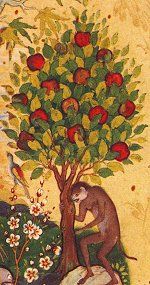Serving the Guest: A Sufi Cookbook
Essays | Recipes | Gallery
In the 14th century, Chinese rice traveled with Timur to North India, Central Asia, and Iran, and until only recently was a regional specialty or luxury item in other parts of the world. Eggplants and melons were transplants to the Middle East from India. In the 18th and 19th centuries, tomatoes, peppers, green beans and paprika migrated from the New World to Spain, then straight-way to the Ottoman Empire. These foods are now basic to the cuisine of the countries of the former Ottoman Empire; it is hard to imagine that they originated anywhere else.

Foods migrate, and so do spiritual teachings. The inner kernel of all revealed religions, ripening in the revelation of Muhammad, Sufism is a spiritual path rooted in full participation in everyday life. Its mystical teachings traveled from Arabia to Iran, Mesopotamia and Central Asia, and thereafter to Africa, Anatolia, India, Sri Lanka, Indonesia, Albania, Bosnia, France, England, and North and South America. Sufi customs have developed within various cultures, with shared elements resulting from Sufism’s roots in Islam. The flavor of each Sufi community is taken from the flavor of the culture from which it grew, and from the emphasis of its founder and leaders.
There is no one "true coin" of Sufism, and no one Sufi cuisine. However, millions of people throughout the world have found in the traditions of Sufism a path for the fulfillment of their life’s purpose, opening their hearts in praise and remembrance of God. And when they’re not fasting, these people often like to break bread together, and share tea and coffee – Turkish, Persian, Indonesian, Chinese, Moroccan, Albanian, English or American-style!
This is a book about the limitless bounty of God — about love, generosity, gratitude, mindfulness, creativity, cultural diversity, and food. It explores both orthodox and mystical teachings on food and hospitality; customs and observances worldwide and throughout history, with emphasis on Sufi communities, called tariqats, and the cultures in which they have thrived; and the metaphoric and esoteric essence of food, cooking and ritual.
The idea for this book was born over a dinner table, a traditional venue for Sufi spiritual discourse. The recipes are an eclectic mix. They include dishes prepared for Sufi gatherings small and large; recipes contributed by members of Sufi communities in the United States and abroad; popular foods eaten in the Muslim world, relished over centuries in celebration after celebration; dishes referred to in travelers’ accounts of Sufi hospitality; and food with ritual significance. Recipes are also included for dishes referred to in the poetry of Rumi, for his favorite food (read on to find out which one!), and others no doubt well-known to him. And there are a few original creations, including the poetically-inspired Rose Fudge — in which the fragrance of the Middle East kisses New England on the cheek.

When the necessity of eating is satisfied in remembrance of God, preparing, eating and sharing meals offer a bridge to awareness of the unity of all creation and the ultimate source of all sustenance. Inshallah– God willing! – this book may point to the transformative potential of this most basic human activity, to a heightened sense of the worldwide community of lovers of God, and, we hope, to a few good meals.
To all those who read and cook from this book, we say,
which is Turkish for,
from Serving the Guest: A Sufi Cookbook
Copyright © 1999, 2000 by Kathleen Seidel
Sources of previously published material by other authors used by permission, and print sources for images, may be found at http://www.superluminal.com/cookbook.